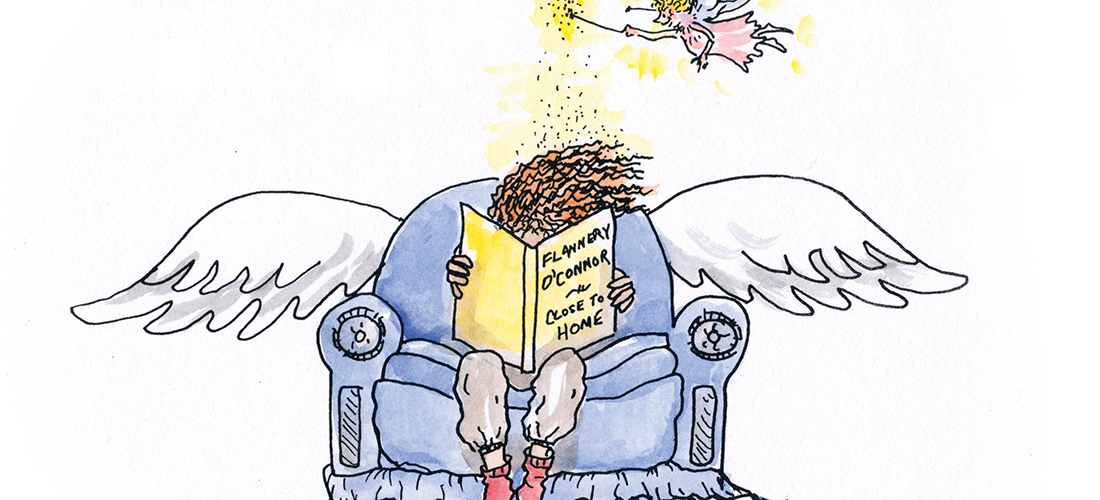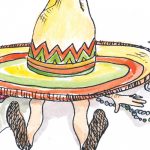
Between Here and There
A homesick Southern girl dives deep into Flannery O’Connor
By Jane Borden
Uh-oh,î I said from the sofa in my Los Angeles apartment. As if the collected works of Flannery O’Connor might respond. Books don’t talk. Authors do, I suppose, but even if O’Connor’s ghost had decided to travel from her grave in Milledgeville, Georgia, just to watch me read her stories, she couldn’t have heard my “uh-oh” utterance over the hip hop music blaring from my neighbor’s car. And suddenly I was then wondering what she would think of Drake and his meteoric rise up the charts — an omen, for sure,
but of what, only she could say.
To read O’Connor’s work is to fall under a spell. It is also a form of travel. And that was the point. I found myself a little closer to home that afternoon. Los Angeles is as far away from Greensboro as New Foundland is. As far away as Colombia. I miss home. I wrote an entire book about figuring out how to move back to the South. Then the cocktail of marriage and career pulled me even farther away. So I prescribed myself some O’Connor. When I was a teenager, her country Georgia folk stayed with me long after class. The Misfit was around every corner. The healer in the river was just beyond every tree line. That afternoon in Los Angeles, I enjoyed feelings of familiarity. But then they became uncomfortably intense.
I said “Uh-oh” because I connected a little too much with the characters in her stories. This is not good. Things don’t end well for O’Connor’s creations. They find themselves shot in the heart; drowned in rivers; or abandoned at truck stops, deaf and mute. I mean, if Flannery is writing my life, the best-possible ending for which I can hope is to have a Bible salesman steal my wooden leg.
Allow me to clarify: I’m not claiming a similarity to her. She was the queen of Southern Gothic, whose beautifully succinct short stories reveal our shortcomings and unquenchable desires. I am also Southern, but if my writing reveals anything, it’s an inability to turn down muffins. O’Connor was invited to the Iowa Writers’ Workshop and the prestigious Yaddo colony in upstate New York; I was once invited to speak at a book club of five people on the Upper East Side. And also to a karaoke birthday party next weekend.
But I am searching, as her characters do, for the same answers regarding origins and endings. Like young Nelson who travels to Atlanta in O’Connor’s story (the one with the title that can’t be reprinted), I inherently long to be where I can shout, “I was born here!” In my book, I described the sickening feeling of asking myself where I was going and realizing I didn’t know. When Mrs. Shortley’s daughter asks her that question in “The Displaced Person,” Mrs. Shortley dies of a stroke, right there at the farm’s gate.
Like I said: Uh-oh. More than anything, I’ve searched for the answer to the question of where home is. But I certainly don’t want to have an aneurism at RDU. So instead of learning from her characters, I’ll take a lesson from O’Connor herself, who suggests that truths can’t be catalogued, that they only exist in the in-betweens and no-wheres, when you’re standing “half in the sunlight and half out,” or when “there was not a cloud in the sky nor any sun.” Perhaps I should simply say, as that Bible salesman does, that “I’m not even from a place, just from near a place.” Better not to nail down home, but drown in its moving current; wherever I am, I’m in it. What O’Connor so beautifully described are the currents themselves. If life can’t be known, it can at least be understood. One of her editors wrote that when they met, he couldn’t decipher a word through her thick accent. But with her pen she was crystal clear. Too bad we never got to hear her karaoke. OH
You can find Greensboro native Jane Borden, author of I Totally Meant To Do That, in L.A. — or at JaneBorden.com.





